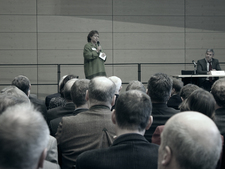There is no way without emergency preparedness
BfS expert workshop radiation protection and emergency preparedness
For as long as the Asse II mine is being operated actively, emergency preparedness (precautions and emergency measures) is required to ensure the protection of man and environment. This is a result of the expert workshop "Radiation Protection and Emergency Preparedness" that was organised by the Federal Office for Radiation Protection (BfS) on 20 and 21 November 2012 in Wolfenbüttel. 130 Asse experts from all over Germany had a vivid and constructive debate which was also controversial at times. Apart from the Federal Environment Ministry (BMU), the Lower Saxon Environment Ministry (NMU), the Asse-2 Accompanying Group and the Asse-GmbH, planners and experts attended the workshop.

![]() BfS Vice-president, Stefanie Nöthel, opened the expert workshop on 20 November 2012
BfS Vice-president, Stefanie Nöthel, opened the expert workshop on 20 November 2012
In order to ensure the protection of man and nature, precautionary measures need to be implemented to reduce the probability of occurrence of an emergency. Planned emergency measures to reduce the consequences of an emergency occurring nevertheless need to be prepared to a sufficient extent. The objective of the BfS is the compatibility of emergency preparedness and the retrieval of the waste. The so-called "saucepan concept" ("retrieval from above") is still being discussed controversially. The BfS takes this into account by investigating other options (retrieval of the waste from the 750-metre or 700-metre level).
The participants also discussed the question how it can be determined in a comprehensible way when they are actually dealing with an emergency. This is done by evaluating different indicators (how much has the inflow increased, have the flow paths and the composition of the saline solutions changed, has the radiological exposure of the solutions increased?). The indicators are evaluated by the experts from the BMU, the NMU, the federal state Mining Authority and the BfS and discussed with the affected population.
Long-term safety
It is necessary to conduct long-term safety assessments with respect to the waste remaining in the mine, in order to be able to react safety-relevantly to non-controllable situations in the mine (emergency preparedness) and to justify the retrieval of the waste. No reduced safety requirements do apply to long-term safety assessments and evaluations with regard to the waste remaining in the Asse mine. What criteria and approaches have to be taken as a basis in detail needs to be clarified and finally be determined by the BMU. Comprehensive information needs to be collected for the long-term safety assessment, in particular on the state of the overburden and on the chemo-toxic components of the waste. It is open whether this can be done in the necessary quality. From the current point of view it is not likely that the result of the long-term safety assessment with regard to the waste remaining in Asse will be positive.
Radiation protection during retrieval of the waste
The employees will be those who will receive the major part of the radiation exposure during the retrieval operations. It will only be possible to assess the exposure concretely after the trial phase (fact-finding) has concluded and after the recovery equipment has been tested. The exposure to the population can be reduced individually by optimising the work steps. Retrieval is planned in such a manner that no employee will be exposed to a non-acceptable risk.
Justification of retrieval of the waste
The exposure to the employees when retrieving the waste is counterbalanced by the exposure to the population in case the waste will remain in the mine. The BfS has the same level of concern for the protection of both the population and the employees. The "justification" of retrieval includes, apart from radiological and health and safety aspects, also societal aspects going beyond this (for example generational fairness). Political decisions set the frame and are the basis for "justification".
Report
The BfS will publish the results gained in this expert workshop. Taking into account these results, the BfS will determine how the acceleration potentials in the single projects will effect the general schedule of the total project "retrieval".
Public briefing
A public briefing on the workshop takes place on Friday, 23 November at 5 p.m. in the Stadthalle Braunschweig.

